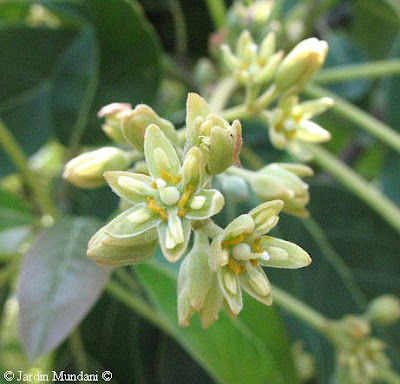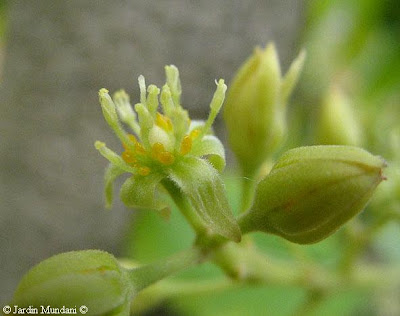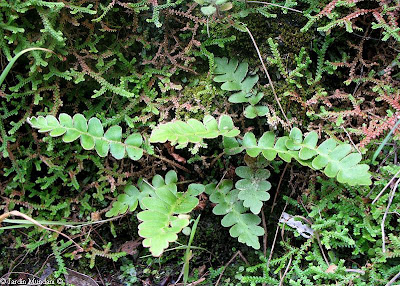Indeed, the reindeers that throw of the sleighs of Lapland´s Eskimos feed on the nutritious sheaths of the carob tree, Ceratonia siliqua, a leguminous arboreal tree cultivated for several millenia in all the coastal zones that border the Mediterranean Sea. The poor and monotonous diet of the reindeers with coriaceous Arctic lichens complement themselves successful with triturated sheaths of the carob beans. The hard seeds were separated to use them like thickeners in the human feeding, pharmaceutical products and the chemical industry.
Old and imposing carob tree of more than 150 years seeded by my great-grandfather in a cereal field of Majorca. It surpasses the 12 meters of height and its trunk measures more of a meter of diameter. During its long life it has given abundant harvests of carob beans. Making a simple calculation, if a normal year produces between 200 and 400 kilos of fruits, multiplying it by last the 130 years of its adult life, it gives a total of 40 tons of carob beans.
On the other hand, the mycorhizes of their roots in their average century and of life have fixed several hundreds of kilos of atmospheric nitrogen in the form of underground nodules that have enriched the poor, argillaceous, calcareous and stony ground where the roots are introduced.
Every spring is born several broods from small birds in the nests that the birds construct on their branches. A pair of hoopoes year after year takes advantage of a hole in the doubling trunk to bring to world one or two broods. The carob tree is, really, a complete ecosystem where hundreds of species of insects, arachnids, birds, small lizards and rodents find a comfortable habitat where to live, to feed themselves and to procreate.
Its dense foliage of dark and coriaceous leaves has given shade to my ancestors during many decades. At noon they sat down, we sat down, in the ground on coats of stuffed esparto of straw in the fresh shade of the old carob tree to eat bread with tomato, salt and olive oil, accompanied by sobrasada, parched cheese, botifarrones, camaiot, bacon roast on live coals, olives flavored with salt and fennel and a few figs dessert droughts, all this watered with a jet of red wine of own production drunk directly of a pumpkin of slim waist, Lagenaria siceraria, with a cork done with a small branch of olive tree. Memory with nostalgy the many sweet hours that I happened playing under this tree in my childhood and the flavorful thing and that felt like their carob beans to me. A pair of them filled the stomach to me and they cleared the hunger to me. They were my picnic. It accompanied sometimes them with some crude almond, that I cracked on a stone.
The carob tree is original of the Eastern Mediterranean. The Phoenicians and the Arabs extended their culture by all the Mediterranean river basin. It is a very resistant tree that supports very well the drought and the torrid sun of the summer. It prefers the good drained limestone grounds since their roots do not support flooded lands. The micorrhizal symbiontic fungi that surround their roots need to breathe to live. The static water prevents the soil oxygenation and drowns to the symbiotic fungi. Without filamentous and white hyphae of the fungus, the carob tree cannot absorb the water and the minerals of the ground and the nodules by the roots cannot fix the nitrogen of the air. It is understood since this enormous leguminous support better one releases drought that the water suspended in its roots, which would drown the micorrhizal fungi and it would suppose the death of the tree by starvation.
This dependency easily verifies when seeding seeds of Ceratonia siliqua in individual flowerpots. If the land of the flowerpot lacks spores of the symbiotic fungus, the small tree just born, after consuming the nutrients that the seed contained, stops growing, yellows, it languishes slowly and it ends up dying. In order to avoid that the young carob tree dies literally of hunger, it is sufficient with adding to the flowerpot a little earth picked up of underneath an old carob tree that contains thousands of spores of the symbiotic fungus, which germinate quickly, his hyphae surrounds the roots of the dying little tree and in few days the miracle takes place. The apical yolk appears vigorously and its growth is spectacular. If a few months later migrates the little tree to a greater flowerpot, is verified like its roots are surrounded by a species of white spiderwebs that smell of good earth. They are hyphae of the micorrhizal symbiontic fungi. Also small stuck gray small balls are the roots. They are the nodules locking devices of atmospheric nitrogen that contribute natural installment to the carob tree.
On the other hand, the mycorhizes of their roots in their average century and of life have fixed several hundreds of kilos of atmospheric nitrogen in the form of underground nodules that have enriched the poor, argillaceous, calcareous and stony ground where the roots are introduced.
Every spring is born several broods from small birds in the nests that the birds construct on their branches. A pair of hoopoes year after year takes advantage of a hole in the doubling trunk to bring to world one or two broods. The carob tree is, really, a complete ecosystem where hundreds of species of insects, arachnids, birds, small lizards and rodents find a comfortable habitat where to live, to feed themselves and to procreate.
Its dense foliage of dark and coriaceous leaves has given shade to my ancestors during many decades. At noon they sat down, we sat down, in the ground on coats of stuffed esparto of straw in the fresh shade of the old carob tree to eat bread with tomato, salt and olive oil, accompanied by sobrasada, parched cheese, botifarrones, camaiot, bacon roast on live coals, olives flavored with salt and fennel and a few figs dessert droughts, all this watered with a jet of red wine of own production drunk directly of a pumpkin of slim waist, Lagenaria siceraria, with a cork done with a small branch of olive tree. Memory with nostalgy the many sweet hours that I happened playing under this tree in my childhood and the flavorful thing and that felt like their carob beans to me. A pair of them filled the stomach to me and they cleared the hunger to me. They were my picnic. It accompanied sometimes them with some crude almond, that I cracked on a stone.
Carob tree of about 30 years loaded of still green fruits at the height of summer. These trees usually seed themselves in poor lands where they prosper without problems. Sometimes they are combined with other fruit trees like the fig trees, the almonds tree, the olive trees, the plum trees and the apricot trees, all of them very rustic trees that support well poor and stony soil.
The carob tree is original of the Eastern Mediterranean. The Phoenicians and the Arabs extended their culture by all the Mediterranean river basin. It is a very resistant tree that supports very well the drought and the torrid sun of the summer. It prefers the good drained limestone grounds since their roots do not support flooded lands. The micorrhizal symbiontic fungi that surround their roots need to breathe to live. The static water prevents the soil oxygenation and drowns to the symbiotic fungi. Without filamentous and white hyphae of the fungus, the carob tree cannot absorb the water and the minerals of the ground and the nodules by the roots cannot fix the nitrogen of the air. It is understood since this enormous leguminous support better one releases drought that the water suspended in its roots, which would drown the micorrhizal fungi and it would suppose the death of the tree by starvation.
This dependency easily verifies when seeding seeds of Ceratonia siliqua in individual flowerpots. If the land of the flowerpot lacks spores of the symbiotic fungus, the small tree just born, after consuming the nutrients that the seed contained, stops growing, yellows, it languishes slowly and it ends up dying. In order to avoid that the young carob tree dies literally of hunger, it is sufficient with adding to the flowerpot a little earth picked up of underneath an old carob tree that contains thousands of spores of the symbiotic fungus, which germinate quickly, his hyphae surrounds the roots of the dying little tree and in few days the miracle takes place. The apical yolk appears vigorously and its growth is spectacular. If a few months later migrates the little tree to a greater flowerpot, is verified like its roots are surrounded by a species of white spiderwebs that smell of good earth. They are hyphae of the micorrhizal symbiontic fungi. Also small stuck gray small balls are the roots. They are the nodules locking devices of atmospheric nitrogen that contribute natural installment to the carob tree.
Bipennate leaves of carob tree, brilliants and coriáceas like of plastic, that is darkened as they age and they persist on the tree during several years before falling. The nutrients that contain incorporate to the ground when being disturbed they enrich and it and they puff up. Each leaf is formed by 5 pairs of leaflets. Raquis and the petiole of the tender leaves and the stem of the new buds have an alive dark pink color.
Still immature carob beans in the middle of the summer. In this state they contain many bitter and astringent tannins that they avoid that the herbivores eat them before their complete maturation.
Branches of Ceratonia siliqua loaded of mature carob beans at the end of the summer. Usually they fall by themselves at the beginning of the autumn, but it is preferable to knock down them with twig blows at the end of summer on ample fabrics prepared under the tree, so that the first rains of the autumn do not rot them.
Fleshy cases of carob tree of a beautiful dark brown color at the beginning of the autumn. Usually they measure between 15 and 25 centimeters in length. The brown pulp that surrounds the seeds is very rich in sugars (until a 30%), proteins, fats, vitamins, pectine, mucilage and tannins. The reason is understood by which most of the production of carob beans of Majorca is exported towards Finland to feed the reindeer of Laponia, since they constitute an excellent very complete and nutritious fodder.
The pulp also is used in confectioner's like substitute of the chocolate. Mixed with wheat flour rich very spongy buns take control of her. The modern ices-cream dealer include the flour of carob bean in their chocolate ice creams and most bold they exclusively make ice creams of carob bean. Also an excellent sweet liquor can be done almost black letting ferment the flour dissolved in water to which grape grains are added to him to contribute necessary leavenings for the fermentation.
The pulp also is used in confectioner's like substitute of the chocolate. Mixed with wheat flour rich very spongy buns take control of her. The modern ices-cream dealer include the flour of carob bean in their chocolate ice creams and most bold they exclusively make ice creams of carob bean. Also an excellent sweet liquor can be done almost black letting ferment the flour dissolved in water to which grape grains are added to him to contribute necessary leavenings for the fermentation.
The carod seeds, calls "garrofines", are very hard and are surrounded by one cuticle shining raincoat to the humidity. This makes very refractory to the germination and at the same time it allows them to conserve his viability during 4 or 5 years. In the nature a short cut exists to accelerate the germination of the seeds: the passage by the alimentary canal of the herbivores that swallow them whole when not being able them to chew and disperses soon them with their lees. The acid of its gastric juice dissolves hard cuticle partially and facilitates the later hydration of the embryo that germinates quickly.
In the zone of Spanish Levante, for the production of establishments of carob trees in the breeding grounds, usually they are used the seeds gathered of the excrements of the cattle, since one knows that its germination is almost of the 100%. In industrial arboriculture on a large scale it is put under the seeds to the action of a sulfuric acid solution concentrated during one or two hours. Another method to break cuticle and to make it permeable to the water consists of submerging garrofines in boiling water and leaving them in soaking while it cools off during 24 - 48 hours. A simple very effective homemade method consists of cutting to a small piece of cuticle with a nail clippers to each carod seed in the cleared part opposed the germinal yolk. This simple method less than accelerates the germination in 10 days.
Carod seeds have a very uniform size and a weight. This characteristic drew attention of the old Arab and Jewish jewelers, used who them as unit of weight for their transactions of gold and precious stones. KIRAT called it with the Arab word = Carat. From KERATONIA comes the scientific name there to him = Ceratonia, that is to say, tree of the carats.
The carob trees can be masculine, feminine and hermaphrodite. Generally the nurserymen reject the masculine feet or graft by the methods of small shield or Majorcan chip with feminine or hermaphrodite yolks. Knowing him sexuality the carob tree is intelligent intercalary some masculine copy in the plantations from feminine carod trees.
In the zone of Spanish Levante, for the production of establishments of carob trees in the breeding grounds, usually they are used the seeds gathered of the excrements of the cattle, since one knows that its germination is almost of the 100%. In industrial arboriculture on a large scale it is put under the seeds to the action of a sulfuric acid solution concentrated during one or two hours. Another method to break cuticle and to make it permeable to the water consists of submerging garrofines in boiling water and leaving them in soaking while it cools off during 24 - 48 hours. A simple very effective homemade method consists of cutting to a small piece of cuticle with a nail clippers to each carod seed in the cleared part opposed the germinal yolk. This simple method less than accelerates the germination in 10 days.
Carod seeds have a very uniform size and a weight. This characteristic drew attention of the old Arab and Jewish jewelers, used who them as unit of weight for their transactions of gold and precious stones. KIRAT called it with the Arab word = Carat. From KERATONIA comes the scientific name there to him = Ceratonia, that is to say, tree of the carats.
The carob trees can be masculine, feminine and hermaphrodite. Generally the nurserymen reject the masculine feet or graft by the methods of small shield or Majorcan chip with feminine or hermaphrodite yolks. Knowing him sexuality the carob tree is intelligent intercalary some masculine copy in the plantations from feminine carod trees.
Inflorescences in the form of swab of a carob tree of masculine sex composed by finished lengths stamens in yellow anthers full of pollen, that leave in groups of six small cleared bases formed by the nectaries.
Masculine inflorescence of Ceratonia siliqua. The red central stem is seen very well del that they leave the cleared nectaries, each one of as surrounded by 6 stamens and its respective yellow anthers. The abundant nectar of the nectaries attracts the pollenizer insects, coverall to the bees that produce an excellent dark honey. I recommend to extend the photo with a double click.
Inflorescences of a feminine carob tree, with the flowers without petals that leave a red central stem. Each flower has a nectary in its base, del that slightly arises pistilo curved and finished in a heavy sticky stigma, on whose surface stick grains of pollen transported by the bees.
Another feminine inflorescence at the end of summer, with the flowering slightly more delayed than the previous ones, because the nectaries without unfolding and nectar are still seen.
Inflorescences of a hermaphrodite carob tree with stamens and pistils distributed throughout the red central stem. In order to avoid the self-fertilization, in the first place the feminine flowers with their nectaries filled with rich nectar are opened to attract the bees with the body covered with the pollen of the masculine flowers of another carob tree.
Another hermaphrodite inflorescence in feminine phase. Masculine stamens remains without developing with closed anthers to avoid the self-fertilization. The feminine stigmata wait for grains of pollen taken by the bees. Once the majority of feminine flowers has been fertilized, the stigmata are closed hermetically, their nectaries stop producing nectar and the growth of the small fruits begins.
After the fertilization of the feminine flowers, the masculine phase in the hermaphrodite inflorescences begins. Stamens are extended and the anthers of their ends are opened and begun to disperse pollen. In their base the nectaries produce abundant nectar so that the bees go and the pollen grains take on their body towards the stigma of the feminine flowers of another carob tree, feminine ones as hermaphrodite ones.
The maturation of the fruits agrees with the flowering. In the photo the mature inflorescences of a feminine carob tree and their fruits at the end of the summer are seen.
After several decades of declivity in their culture, in the last years become to seed young, single or mixed carob trees with olive trees, almond trees and fig trees, because its operation is a business with few expenses and little manpower that can be profitable as of the second decade of the life of the trees.



















































